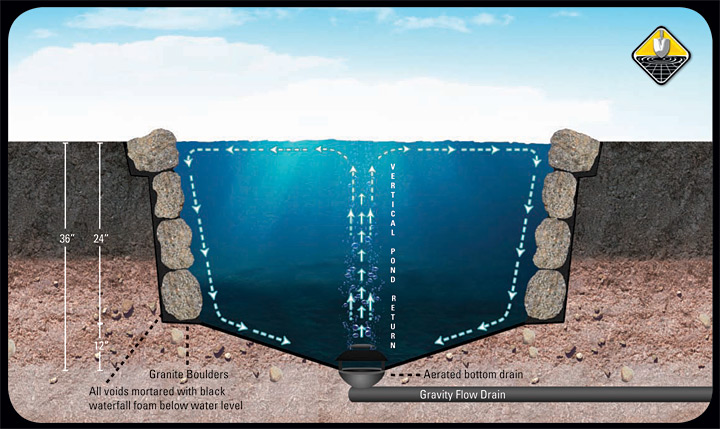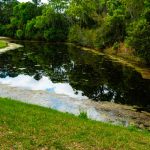To drain a pond, locate the drain valve at the bottom and open it completely, allowing the water toflow out. Use a hose to siphon remaining water if necessary.
Importance Of Draining A Pond
Properly draining a pond is essential for maintaining a healthy aquatic environment. Over time, organic debris, silt, and excess nutrients can accumulate in a pond, leading to poor water clarity, increased algae growth, and decreased oxygen levels. Regularly draining the pond can help mitigate these issues and improve the overall water quality.
Avoiding Algae Overgrowth
Draining a pond helps prevent algae overgrowth by removing the accumulation of organic matter and nutrients that fuel its growth. Excess nutrients from decaying plant material and animal waste can contribute to algae proliferation. By periodically draining the pond, these nutrients are reduced, making it less favorable for algae to thrive.
Improving Water Quality
Regular pond drainage is crucial for improving water quality. As debris and silt build up over time, the water can become murky and nutrient-rich, creating a hospitable environment for bacteria and algae. Draining the pond allows for the removal of accumulated sediment, leading to clearer, cleaner water that supports a healthier ecosystem.

Credit: theponddigger.com
Assessing The Pond
Before draining your pond, it’s crucial to assess its condition thoroughly.
Determining Water Volume
Calculate the total water volume of your pond to know how much water you need to remove.
Identifying Blockages
- Inspect for any debris or clogs that may hinder water drainage.
- Remove any obstructions to ensure a smooth draining process.
Gathering Necessary Equipment
Prior to draining a pond, it is crucial to gather the necessary equipment for a smooth and efficient process. Having the right tools on hand will make the task much easier and help prevent any disruptions or delays. In this section, we will discuss the key equipment you will need to successfully drain your pond.
Pump Selection
Choosing the right pump is essential to effectively drain a pond. Consider the size of your pond and the amount of water you need to remove. Ensure that the pump has sufficient power and a suitable flow rate for the task at hand. Additionally, opt for a submersible pump specifically designed for water removal, as it will be able to handle the job with ease.
Hose And Discharge Planning
Once you have selected a suitable pump, it’s time to focus on the hose and discharge planning. Firstly, determine the length and diameter of the hose required to reach your desired drainage location. Ensure the hose is sturdy enough to handle the water flow and is long enough to conveniently reach the discharge point.
Next, plan the discharge location carefully. Ideally, choose an area that is downhill from the pond to allow for easier water flow. Ensure that the discharge area is suitable for the pumped water, considering factors such as soil saturation and potential environmental impact. It’s also important to check any local regulations or restrictions regarding water drainage to avoid any legal complications.
By properly gathering the necessary equipment, such as selecting the right pump and planning the hose and discharge location, you will be well-prepared to successfully drain your pond. Next, we will discuss the step-by-step process of draining the pond effectively.

Credit: www.yardfocus.com
Creating An Effective Drainage Point
Learn how to effectively drain your pond by creating proper drainage points. Ensure the water flow is controlled to prevent flooding and maintain the pond’s health. Implementing smart drainage strategies is essential for keeping your pond in optimal condition.
Creating an Effective Drainage Point One of the most crucial steps in draining a pond is creating an effective drainage point. This ensures that the water is efficiently and quickly drained from the pond, preventing any potential flooding or damage to the surrounding areas. In this section, we will discuss some important considerations when choosing the location for your drainage point and how to install the sump pump correctly.Location Considerations
Before you start installing the drainage point, you need to carefully consider the location. Here are some key factors to keep in mind: 1. Pond Size: Determine the size of your pond, as this will influence the location of your drainage point. Ideally, it should be near the lowest point of the pond to ensure proper drainage. 2. Proximity to Property: Be mindful of your pond’s proximity to your property to avoid any damage or inconvenience. Ensure that the drainage point is positioned away from any structures, such as buildings or fences. 3. Accessibility: Choose a location that allows easy access for maintenance and repairs. You don’t want to struggle to reach the drainage point when it’s time to clean or inspect it. 4. Discharge Destination: Consider where the water will go once it is drained from your pond. Ensure that it will not pose a risk to neighboring properties or natural water sources.Installing The Sump Pump
Now that you have chosen the perfect location, it’s time to install the sump pump. Here’s what you need to do: 1. Excavation: Start by excavating the area where the drainage point will be located. Dig a pit deep enough to accommodate the sump pump and allow water to collect. 2. Leveling: Ensure that the excavation area is properly leveled to prevent any water pooling or uneven drainage. 3. Fit the Pump: Place the sump pump inside the excavation area. Make sure it is securely positioned to avoid any movement during operation. 4. Connect the Discharge Pipe: Attach a suitable discharge pipe to the pump’s outlet. This pipe will carry the drained water away from the pond. 5. Secure the Pipe: Properly secure the discharge pipe to prevent any leaks or disconnections. Use zip ties or clamps to secure the pipe firmly in place. 6. Test the Pump: Before completing the installation, test the pump to ensure it is functioning correctly. Fill the pond with water and observe if the pump efficiently drains the water through the discharge pipe. By considering the location and installing the sump pump correctly, you can create an effective drainage point for your pond. This will help keep your pond in optimal condition and prevent any unwanted water buildup.Executing The Drainage Process
To properly drain a pond, start by removing any debris and vegetation from the area. Then, use a pump to gradually drain the water, ensuring it doesn’t overwhelm the surrounding environment. Once the water level is lowered, prioritize removing any remaining sediment to prevent future issues with water quality and pond health.
Activating The Pump
If you want to effectively drain your pond, activating a pump is crucial. This device will do the hard work for you by removing water from the pond and transferring it to another location. Follow these steps to activate the pump:
- Ensure that the pump is connected to a power source.
- Check the pump’s manual for specific instructions on startup.
- Prime the pump by filling the intake hose with water.
- Start the pump and allow it to run until it reaches its optimal performance.
If you encounter any issues or have concerns about pump operation, refer to the manufacturer’s instructions or seek professional assistance.
Monitoring Progress
While the pump does its job, it is important to monitor the drainage process to ensure everything is running smoothly. Here are some tips on how to monitor progress:
- Regularly check the water level in the pond to gauge how much water has been drained.
- Observe the flow of water from the pump to ensure there are no blockages or interruptions.
- Keep an eye on the pump itself to ensure it is functioning without any unusual noises or vibrations.
- Monitor the surrounding area for any signs of excessive moisture or flooding.
By actively monitoring the drainage process, you can quickly address any issues that may arise and ensure a successful drain.

Credit: www.uapb.edu
Disposing Of Drained Water
When it comes to draining a pond, one crucial aspect is the proper disposal of the drained water. Disposing of Drained Water needs to be done responsibly to minimize any negative impact on the environment.
Proper Discharge Methods
There are specific methods that should be followed when discharging drained water. It is vital to adhere to local regulations and guidelines regarding the discharge of water into storm drains, creeks, or other natural water bodies. Seeking guidance from local authorities or environmental agencies can help in determining the permissible discharge methods.
Environmental Considerations
Environmental considerations play a significant role in the proper disposal of drained water. It’s essential to avoid discharging water that may contain harmful chemicals or pollutants. Being mindful of the impact on local ecosystems and wildlife is crucial in selecting the appropriate discharge method.
Post-drainage Maintenance
Once your pond has been drained, it’s essential to carry out post-drainage maintenance to ensure the health and beauty of your pond. This crucial step involves cleaning the pond bed, refilling, and balancing the water, which are key to the overall maintenance of your pond.
Cleaning The Pond Bed
After draining the pond, it’s important to thoroughly clean the pond bed to remove any accumulated debris, sludge, or algae. Make sure to carefully scrub the surfaces and remove any leftover organic matter to prevent the growth of harmful bacteria in the future.
Refilling And Balancing
Refilling the pond with fresh water is vital, but it must be done with caution to ensure proper balance. Use a water conditioner to remove any harmful chemicals and detoxify the water to create a healthy environment for fish and plants. Test the water regularly for pH, ammonia, and nitrate levels to maintain optimal conditions.
Preventing Future Pond Overload
- Implement routine debris removal to prevent blockages.
- Monitor algae growth through regular inspections.
- Trim overhanging vegetation to minimize organic matter buildup.
- Consider the impact of weather patterns on pond water levels.
- Manage nearby sources of runoff to prevent contamination.
- Control nutrient levels to avoid excessive plant growth.
Conclusion
After following these steps to drain your pond, you can enjoy a clean and healthy water feature. Remember to maintain proper drainage to avoid future issues. Regular maintenance will keep your pond in top condition for years to come. Start draining your pond with confidence today!




